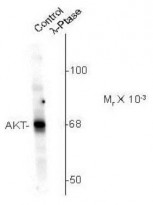ARG54951
anti-Akt phospho (Thr342) antibody
anti-Akt phospho (Thr342) antibody for Western blot and D. melanogaster
Cancer antibody; Cell Death antibody; Gene Regulation antibody; Metabolism antibody; Signaling Transduction antibody; Glucose uptake: Insulin Receptor Dependent Pathway Study antibody
Overview
| Product Description | Rabbit Polyclonal antibody recognizes Akt phospho (Thr342) |
|---|---|
| Tested Reactivity | Dm |
| Tested Application | WB |
| Specificity | Specific for the ~68k AKT protein phosphorylated at Thr342. Immunolabeling is completely eliminated with lambda-phosphatase treatment. It has been reportedthat this antibody may also recognize some level of phosphorylated S6K as there is 67% homology with the sequence used as antigen. |
| Host | Rabbit |
| Clonality | Polyclonal |
| Isotype | IgG |
| Target Name | Akt |
| Antigen Species | Drosophila |
| Immunogen | Phosphospecific peptide around Thr342 of Drosophila AKT. |
| Conjugation | Un-conjugated |
| Alternate Names | Protein kinase B alpha; Proto-oncogene c-Akt; RAC; PKB alpha; RAC-ALPHA; CWS6; PRKBA; AKT; PKB; RAC-PK-alpha; PKB-ALPHA; RAC-alpha serine/threonine-protein kinase; EC 2.7.11.1; Protein kinase B |
Application Instructions
| Application Suggestion |
|
||||
|---|---|---|---|---|---|
| Application Note | * The dilutions indicate recommended starting dilutions and the optimal dilutions or concentrations should be determined by the scientist. | ||||
| Observed Size | 68 kDa |
Properties
| Form | Liquid |
|---|---|
| Purification | Affinity purification with phospho-specific peptide and the non-phospho specific antibodies were removed by chromatography using non-phosphopeptide. |
| Buffer | 10 mM HEPES (pH 7.5), 150 mM NaCl, 50% Glycerol and 100 µg/ml BSA. |
| Stabilizer | 50% Glycerol and 100 µg/ml BSA |
| Storage Instruction | For continuous use, store undiluted antibody at 2-8°C for up to a week. For long-term storage, aliquot and store at -20°C or below. Storage in frost free freezers is not recommended. Avoid repeated freeze/thaw cycles. Suggest spin the vial prior to opening. The antibody solution should be gently mixed before use. |
| Note | For laboratory research only, not for drug, diagnostic or other use. |
Bioinformation
| Gene Symbol | Akt1 |
|---|---|
| Gene Full Name | v-akt murine thymoma viral oncogene homolog 1 |
| Background | The serine-threonine protein kinase encoded by the AKT1 gene is catalytically inactive in serum-starved primary and immortalized fibroblasts. AKT1 and the related AKT2 are activated by platelet-derived growth factor. The activation is rapid and specific, and it is abrogated by mutations in the pleckstrin homology domain of AKT1. It was shown that the activation occurs through phosphatidylinositol 3-kinase. In the developing nervous system AKT is a critical mediator of growth factor-induced neuronal survival. Survival factors can suppress apoptosis in a transcription-independent manner by activating the serine/threonine kinase AKT1, which then phosphorylates and inactivates components of the apoptotic machinery. Mutations in this gene have been associated with the Proteus syndrome. Multiple alternatively spliced transcript variants have been found for this gene. [provided by RefSeq, Jul 2011] |
| Function | Serine/threonine kinase involved in various developmental processes. During early embryogenesis, acts as a survival protein. During mid-embryogenesis, phosphorylates and activates trh, a transcription factor required for tracheal cell fate determination. Also regulates tracheal cell migration. Later in development, acts downstream of PI3K and Pk61C/PDK1 in the insulin receptor transduction pathway which regulates cell growth and organ size, by phosphorylating and antagonizing FOXO transcription factor. Controls follicle cell size during oogenesis. May also stimulate cell growth by phosphorylating Gig/Tsc2 and inactivating the Tsc complex. Dephosphorylation of 'Ser-586' by Phlpp triggers apoptosis and suppression of tumor growth. [UniProt] |
| Research Area | Cancer antibody; Cell Death antibody; Gene Regulation antibody; Metabolism antibody; Signaling Transduction antibody; Glucose uptake: Insulin Receptor Dependent Pathway Study antibody |
| Calculated MW | 68 kDa |
| PTM | O-GlcNAcylation at Thr-305 and Thr-312 inhibits activating phosphorylation at Thr-308 via disrupting the interaction between AKT1 and PDPK1. O-GlcNAcylation at Ser-473 also probably interferes with phosphorylation at this site. Phosphorylation on Thr-308, Ser-473 and Tyr-474 is required for full activity. Activated TNK2 phosphorylates it on Tyr-176 resulting in its binding to the anionic plasma membrane phospholipid PA. This phosphorylated form localizes to the cell membrane, where it is targeted by PDPK1 and PDPK2 for further phosphorylations on Thr-308 and Ser-473 leading to its activation. Ser-473 phosphorylation by mTORC2 favors Thr-308 phosphorylation by PDPK1. Phosphorylated at Thr-308 and Ser-473 by IKBKE and TBK1. Ser-473 phosphorylation is enhanced by interaction with AGAP2 isoform 2 (PIKE-A). Ser-473 phosphorylation is enhanced in focal cortical dysplasias with Taylor-type balloon cells. Ser-473 phosphorylation is enhanced by signaling through activated FLT3. Dephosphorylated at Thr-308 and Ser-473 by PP2A phosphatase. The phosphorylated form of PPP2R5B is required for bridging AKT1 with PP2A phosphatase. Ser-473 is dephosphorylated by CPPED1, leading to termination of signaling. Ubiquitinated via 'Lys-48'-linked polyubiquitination by ZNRF1, leading to its degradation by the proteasome (By similarity). Ubiquitinated; undergoes both 'Lys-48'- and 'Lys-63'-linked polyubiquitination. TRAF6-induced 'Lys-63'-linked AKT1 ubiquitination is critical for phosphorylation and activation. When ubiquitinated, it translocates to the plasma membrane, where it becomes phosphorylated. When fully phosphorylated and translocated into the nucleus, undergoes 'Lys-48'-polyubiquitination catalyzed by TTC3, leading to its degradation by the proteasome. Also ubiquitinated by TRIM13 leading to its proteasomal degradation. Phosphorylated, undergoes 'Lys-48'-linked polyubiquitination preferentially at Lys-284 catalyzed by MUL1, leading to its proteasomal degradation. Acetylated on Lys-14 and Lys-20 by the histone acetyltransferases EP300 and KAT2B. Acetylation results in reduced phosphorylation and inhibition of activity. Deacetylated at Lys-14 and Lys-20 by SIRT1. SIRT1-mediated deacetylation relieves the inhibition. [UniProt] |
Images (1) Click the Picture to Zoom In






